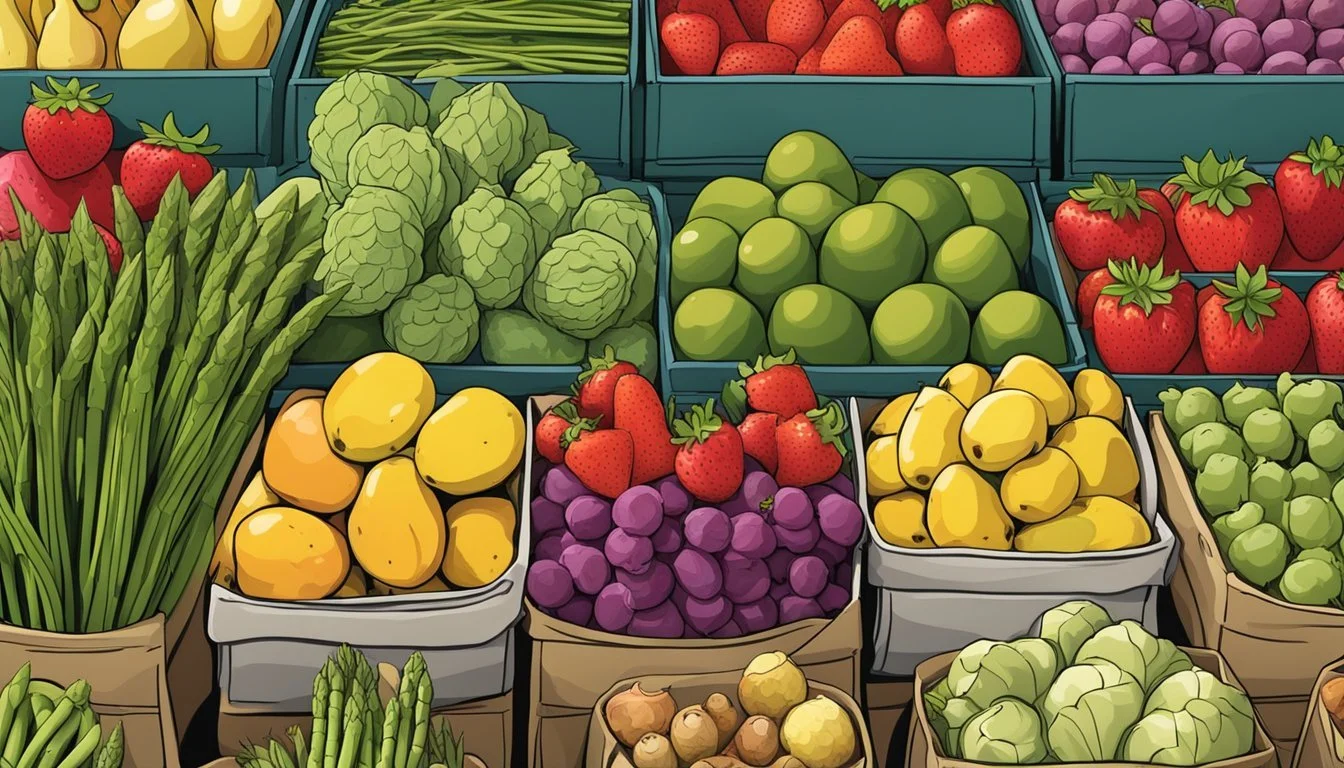Oregon Seasonal Fruit & Vegetables in April
A Buyer's Guide to Fresh Produce
This Article is Part of our Oregon Seasonal Fruit & Veg Calendar
Oregon's diverse climate yields a rich variety of fruits and vegetables that change with the seasons. As April ushers in the spring, the state's agricultural landscape becomes particularly vibrant, offering an array of seasonal produce to local markets and restaurants. This period marks a transition where the last of winter’s harvest meets the beginning of spring’s bounty.
In April, Oregon's fertile fields begin to yield spring vegetables. Asparagus (how long does asparagus last?) spearheads the arrival of spring with its peak season starting this month, while gardeners and farmers also start to harvest leafy greens. April's cool yet temperate weather is ideal for these crops, making them not only fresh but also full of flavor.
Fruit offerings may still be limited in comparison to what the summer will bring, but it is a time for berries to start becoming more prominent. The groundwork for a fruitful berry season is laid as the plants begin to flower and ripen. Rhubarb, often used in pies and desserts, also comes into season, adding a tart option to Oregon's April produce. With each month, the variety of available seasonal fruit and vegetables expands, reflecting the natural growth cycles and sustainable agriculture of the region.
Overview of Oregon's Growing Season
Oregon's diverse climate allows for a rich tapestry of fruits and vegetables that grow throughout the year. Spring in Oregon ushers in a period of renewal, where warmer temperatures and increased daylight stimulate growth in a variety of produce. The spring month of April is a transition time in the Oregon growing season, moving from the cool-weather crops of winter to the beginnings of summer abundance.
In the western part of the state, where the climate is more temperate due to the Pacific Ocean's influence, farmers start to see the fruits of their labor. Spring crops benefit from the region's mild and wet conditions, which are ideal for a range of early vegetables.
Notable spring produce in Oregon:
Asparagus begins in April, thriving as the days grow longer.
Greens such as lettuce and kale emerge, offering a fresh burst to the season's palate.
Rhubarb also makes its appearance, often one of the first signs of spring in the kitchen.
As the state progresses into summer, a wider array of fruits and vegetables come into season, but April's significance lies in its role as a bridge between the root-heavy bounty of winter and the tender offerings of summer.
In contrast, the eastern and central regions of Oregon, with their more extreme seasonal temperature fluctuations, adapt their cropping patterns to match the drier and often colder high desert climate, focusing on hardy produce that can withstand variability.
Oregon's farming community remains vigilant and adaptive, ensuring that even in the shifting weather patterns of April, there is a steady flow of fresh, locally-sourced produce. This interplay between weather, land, and grower expertise defines the state's growing season, framing a picture of resilience in the agricultural sector.
Benefits of Seasonal Eating
Eating seasonally can offer numerous benefits, from enhanced flavor and nutritional content to supporting local agriculture. When consumers choose to purchase and consume fruits and vegetables that align with Oregon's growing cycles, they often experience a significant difference in taste. Seasonal crops are harvested at their peak ripeness, leading to superior flavor and texture.
Nutritionally, seasonal produce tends to have higher levels of vitamins and antioxidants. During peak season, fruits and vegetables are more abundant and potentially less expensive, due mainly to the reduced transportation and storage costs. By focusing on what is currently in harvest, individuals can often add a wider variety of nutrients to their diet, as different produce are available throughout the year.
Seasonal Crops in April Health Benefits Asparagus High in Fiber, Vitamins A, C, E Rhubarb Rich in Minerals, Vitamin K Radishes Excellent Source of Vitamin C Peas Contains Iron, Magnesium
In addition to personal health benefits, seasonal eating supports local farms. It encourages sustainability and economic growth within the community. When consumers purchase directly from farmers or at local markets, they help to reduce the carbon footprint associated with long-distance food transport.
Moreover, seasonal eating can foster a deeper connection between consumers and their food sources. Understanding where and how food is grown promotes a greater appreciation for the effort and resources involved in food production. Aligning one's diet with the seasons reinstates a natural rhythm to eating, which has fed societies long before global trade made all produce available year-round.
Fruits and Vegetables to Buy in April
April marks a time of abundance in Oregon as spring brings forth a fresh selection of fruits and vegetables. Shoppers can indulge in the season’s first wave of produce, characterized by tender, flavorful, and nutritious picks.
Leafy Greens and Herbs
Oregon's spring gardens are resplendent with vibrant leafy greens and aromatic herbs. Produce to look for includes:
Lettuce: Fresh and crisp, perfect for salads.
Spinach: Nutrient-rich and versatile for cooking or raw consumption.
Greens: A variety such as kale and arugula is available, each offering a unique flavor and texture.
Herbs: Fresh parsley, mint, thyme, and rosemary enhance any dish with their freshness.
Root Vegetables and Tubers
The cooler ground of early spring yields a selection of hearty root vegetables and tubers:
Potatoes: A staple, perfect for a variety of dishes.
Beets: Sweet and earthy, ideal for roasts and salads.
Carrots: Crunchy and sweet, excellent both raw and cooked.
Turnips and Radishes: Provide a peppery kick to dishes.
Onions: A foundational ingredient in many recipes.
Spring Vegetables
April sees the emergence of tender spring vegetables, much awaited by chefs and home cooks alike:
Asparagus: Its arrival is celebrated for its delicate flavor and versatility.
Peas: Sweet and tender, perfect for a quick sauté or as a fresh salad addition.
Leeks: Subtly sweet, ideal for soups and stews.
Cauliflower and Broccoli: Ideal for roasting or steaming.
Cabbage: From stir-fry to coleslaw, it is a diverse ingredient.
Early Season Fruits
While the full bounty of fruit is yet to come, April offers its own delights:
Rhubarb: Often paired with strawberries, it’s perfect for pies and compotes.
Other April Produce
Beyond the categories listed above, other produce items to keep an eye out for include:
Artichokes (how long do artichokes last?): Rich in flavor, they are great steamed or grilled.
Fennel (how long does fennel last?): With its unique anise-like flavor, it adds character to any salad.
Green Garlic and Scallions: They are milder than mature garlic and onions but add a wonderful depth of flavor to spring dishes.
Preparation and Storage Tips
Asparagus: They should be consumed within a couple of days if possible. To store, trim the ends, stand them upright in a container with water at room level, and cover loosely with a plastic bag.
Basil: Basil wilts quickly; it's best kept at room temperature with stems in water. Avoid refrigeration as it can turn basil black.
Beets: Store beets in a plastic bag in the refrigerator where they can last for weeks. To maintain freshness, separate the leaves from the roots before refrigerating.
Blackberries & Blueberries: Keep berries dry in the refrigerator and wash only just before use to prevent mold and extend their shelf life.
Broccoli: Store in the refrigerator in a breathable produce bag and use within a few days to ensure they remain firm and fresh.
Brussels Sprouts: Place them in a container or a plastic bag in the fridge's crisper, where they stay fresh for several weeks.
Cabbage: Keep it in the refrigerator where it can last for weeks. If cut, wrap the remainder in plastic wrap.
Cantaloupes (how long does cantaloupe last?): Once ripe, store in the refrigerator to keep them from becoming overly soft or mushy.
Fruits & Vegetables Preparation Storage Rhubarb Cut the leaves off Wrap in plastic, refrigerate Citrus Fruits Room temperature brings out most juice Keep in refrigerator drawer Pears and Apples They emit ethylene, which ripens other produce, store separately Refrigerate in plastic bags
One should consume fresh produce shortly after purchase to enjoy their full nutritional benefits. For longer storage, preservation methods such as freezing, canning, or drying can be implemented to extend the enjoyment of these seasonal offerings.
Where to Find Fresh Produce
In Oregon, April marks the arrival of spring and the beginning of the fresh produce season. Consumers looking to purchase fresh, in-season produce such as asparagus, rhubarb, and early greens have several options.
Farmers Markets: A visit to local farmers markets provides an opportunity to buy directly from growers. Markets are often stocked with the freshest, organic selections, supporting local agriculture. Most neighborhoods or towns host weekly markets where farmers present their latest harvest.
CSA Programs: Community Supported Agriculture (CSA) programs are another avenue for obtaining seasonal produce. When you join a CSA, you receive a share of the farm's production every week or bi-weekly, often with the option for organic products.
Local Farms: Purchasing straight from the farm can sometimes be the best way to ensure the produce is picked at peak freshness. Several Oregon farms offer the chance to buy on-site or through pre-arranged orders.
Organic Food Stores: For those who prefer organic produce, specialized organic stores and sections within supermarkets offer a range of fresh, pesticide-free fruits and vegetables. These stores frequently source from local farms to guarantee freshness.
Remember that buying locally not only provides the freshest seasonal produce but also supports the local economy and reduces the environmental impact of long-distance food transport. Here is a table summarizing the produce typically available in Oregon during April:
Fresh Produce Availability Asparagus Available Rhubarb Available Early Greens Starting
Engaging with the local food scene ensures that you'll enjoy fresh, nutritious, and flavorful ingredients while contributing to the sustainability of Oregon agriculture.
Oregon's April Food Events and Festivals
In April, Oregon's food scene celebrates the arrival of spring with events and festivals that spotlight the state's rich agricultural heritage and community spirit.
Wooden Shoe Tulip Fest runs until April 30th at the Wooden Shoe Tulip Farm in Woodburn. Here, visitors can enjoy the vibrant colors of forty acres of tulip fields. The festival not only offers beautiful scenes and photo opportunities but also reflects Oregon's appreciation for its flowering landscapes and the start of the growing season.
Another highlight of the month is the Food Northwest Process & Packaging Expo held at the Oregon Convention Center in Portland. Although primarily industry-focused, it serves as a marker for the latest innovations in the food and beverage sector that supports local producers and has a trickle-down effect on the region's food culture.
A celebration of local harvest comes with the Annual Pear Blossom Festival in Medford, which features an array of locally made products. From wines and brews to artisan foods, the community gathers to honor local agriculture and culinary traditions. The accompanying Pear Blossom Run and Pear Blossom Parade bring thousands of participants and spectators, showcasing Oregon's commitment to fostering a sense of community through food-centric celebrations.
These festivals in April embody the zest of Oregon's food culture and community, uniting producers, families, and food enthusiasts in a month-long celebration of the state's agricultural bounty.
April Gardening Tips for Oregon
In Oregon, April is a pivotal month for gardening. It sets the stage for the upcoming growth surge in spring and summer. Gardeners are advised to prepare their soil, selecting the appropriate amendments to enrich it before planting.
For vegetable gardens, one should consider planting cool-weather crops such as:
Beets
Carrots
Radishes
Peas
Spinach
Lettuce
These vegetables can tolerate the cooler temperatures still present in April. Utilizing raised beds or row covers can offer extra warmth if necessary.
In terms of fruits, gardeners in Western Oregon should focus on maintenance tasks like pruning berry bushes and grapevines to encourage healthy growth and fruit production in the later months.
Herbs like chives and parsley can also be sown or planted out at this time. They’ll benefit from the April weather and be ready for use throughout the growing season.
Task Details Soil Preparation Amend with compost; test and correct pH. Planting Sow seeds for cool-weather crops. Pest Control Watch for slugs; use organic methods. Fertilizing Apply balanced fertilizers as necessary. Pruning Prune berry bushes and grapevines.
Lastly, it's important to track local forecasts and avoid planting during anticipated frost days. Knowledge of the last frost date is crucial to planting schedules, especially for tender plants. Gardeners should tailor their tasks according to their specific regions within Oregon, as the climate can vary significantly.









